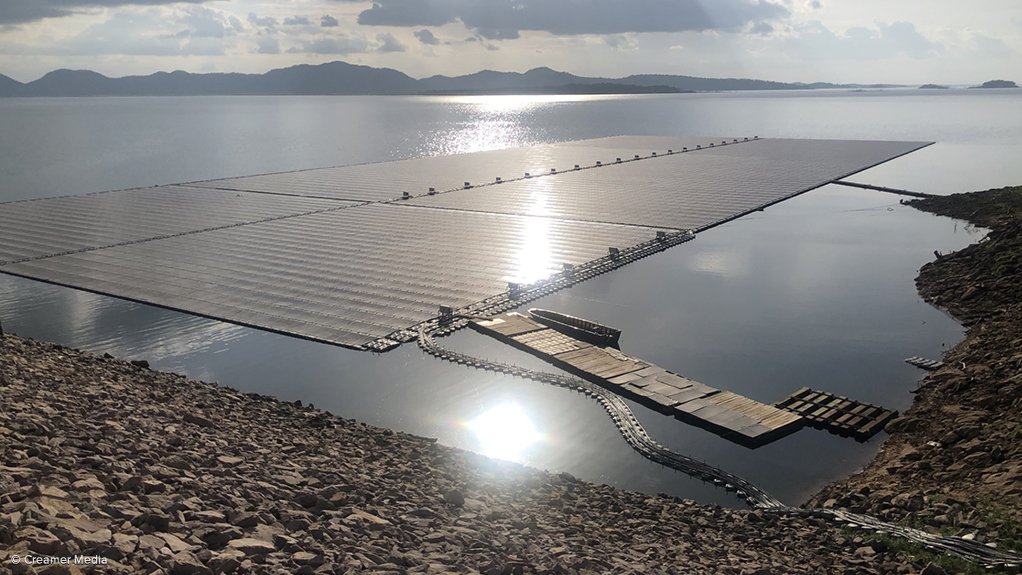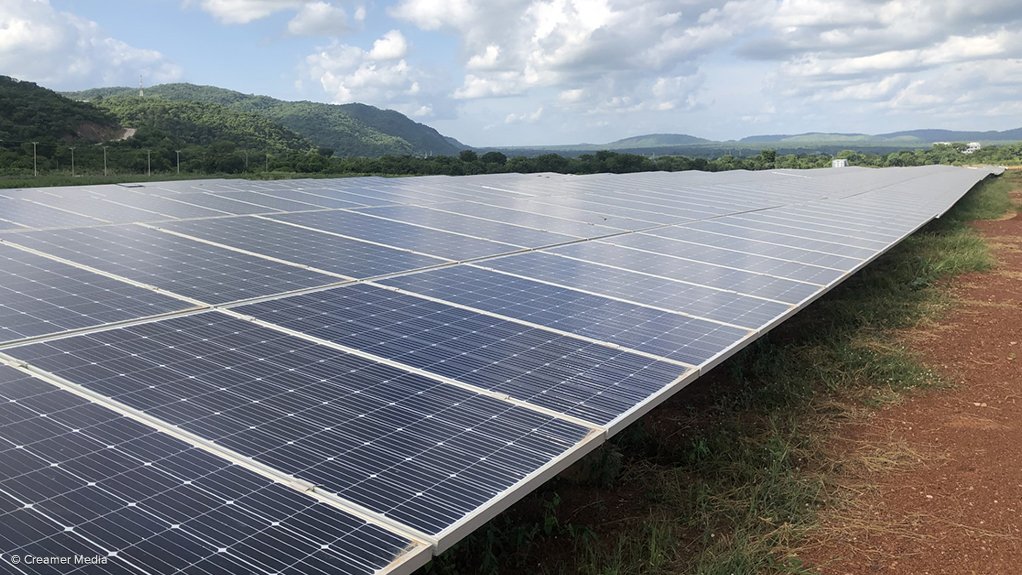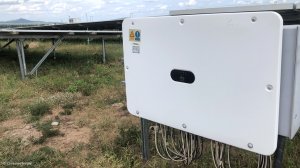Ghana authority to expand solar and hydro capacity





5 MW floating solar plant at the Bui dam in Ghana
Photo by Creamer Media's Darren Parker
Huawei battery energy storage solutions at the Bui solar plant
Photo by Creamer Media's Darren Parker
Huawei inverters at the Bui solar plant
Photo by Creamer Media's Darren Parker
50 MW Solar PV plant near the Bui dam in Ghana
Photo by Creamer Media's Darren Parker
Ghana’s Bui Power Authority (BPA), with the collaboration of the grid operator, is planning on constructing a new 50 MW solar photovoltaic (PV) farm, in Dagbon, in the north of the country.
This is scheduled to be completed by the end of this year, BPA CEO Samuel Kofi Dzamesi has told Engineering News.
Speaking to journalists in Accra, Ghana, on June 14, Dzameni said the project would include the construction of an additional 5 km of transmission lines, enabling a significant improvement in electricity distribution.
This development is just one addition to Ghana’s growing electricity supply, which incorporates a mix of hydro, solar, natural gas and thermal, with aspirations to add nuclear power over the next few decades.
“We must understand that every solar plant requires a baseload. The more we go into solar and other energies, we must set our baseload right. So, as I speak, we have just concluded the selection of a consultant to do total feasibility studies on the three western rivers –
Pra, Ankobra and Tano – as well as the Wli waterfall, for additional hydropower to complement the existing Bui hydro capacity. We hope to have a close on the award within 18 months,” Dzamesi said.
These proposed new hydropower projects will complement the existing Bui hydropower generation plant, located in the Banda district of the Bono region of Ghana, in a remote location with a population of about 28 179.
Construction of the Bui dam power plant began about 15 years ago, with its first power generation having come on line about ten years ago.
The hydroelectric plant has been connected in stages and has an installed capacity of 404 MW from four generating units, including three 133.33 MW Francis turbine units and a 4 MW turbinette. The output is channeled into the national grid.
The Bui hydropower facility has recently added a solar PV component, including a new floating solar power plant, creating Ghana’s first hydro-solar hybrid (HSH) system.
The construction of the solar plants near the Bui dam began in October 2019, with the initial 50 MW solar PV facility starting to operate in November 2020. In total, the BPA plans to expand the solar PV facility to 250 MW in the near future.
The BPA then commissioned a 5 MW floating solar plant earlier this year, the first of its kind in the West African sub-region. Initially, a 1 MW floating solar plant was built on the dam to assess the feasibility of the concept. This was followed soon after by an additional 4 MW of floating solar capacity.
The goal is to now expand this out to 65 MW in total, adding capacity in increments of 10 MW at a time.
The solar PV installations are expected to reduce greenhouse-gas emissions by more than 47 000 t/y.
This strategy complements and reinforces the hydropower facility by ensuring the more sustainable use of its reservoir. The floating solar will lead to better water conservation in the dam owing to reduced water evaporation.
Ghana’s total renewable power output now contributes up to about 7% of the total power generated in-country.
These developments, collectively known as the Bui Generating Station (BGS), supply power through the 161 kV Bui switchyard to the National Interconnected Transmission System (NITS).
At the BGS, the solar addition to the hydro dam, along with the series of 10 MW battery energy storage solutions (BESS) supplied by Chinese information and communication technology (ICT) company Huawei, helps provide a continuous and stable supply of electricity to the grid, even when water levels are low in the dry season.
Dzameni explained that, to keep the electrical grid operating correctly, supply and demand needed to be carefully balanced. When this is not adequately achieved, voltage changes can cause power outages and other malfunctions, causing damage to electrical equipment.
The Huawei BESS is used at the BGS for peak regulation, enabling a smoother power output. When renewable electricity generation surges, such as during hours of peak sunshine, the batteries in the storage system charge by drawing the excess power. Power is then injected back into the grid during drops in output from the dam or solar plants to smooth out fluctuations.
Smart digital technology supplied by Huawei connects these networks to make the processes seamless.
The reliability of the numerous Huawei inverters used on site, a key component responsible for converting the direct current power generated by solar power plants into alternating current power transmitted over the grid, is also of critical importance to ensuring stability of the BGS.
According to a report issued by TÜV in March last year, Huawei's PV solutions managed to ensure a 99.999% availability based on the operation data of a 2.2 GW project in Qinghai, China. The company’s smart PV solutions are designed to withstand harsh environmental conditions, making it a good fit for Africa, which is part of the reason that they are being used in Ghana.
Huawei’s BESS uses special high-density lithium batteries, which frees up 40% of the floor space.
Central to the operation of the BGS is Huawei’s smart grid, which is based on an evolved long-term evolution (eLTE) private network solution, which is a broadband LTE solution based on the 1 785 MHz to 1 805 MHz licensed spectrum. It provides industrial customers with a comprehensive network that integrates wireless broadband access, trunking service, data transmission and video viewing functions.
“Huawei's eLTE solution at the Bui dam exemplifies how ICTs can optimise operations and enhance efficiency. This broadband private network provides wireless coverage across the entire site, enabling real-time communication between the control office and the on-site workforce, improving response times to maintenance requests and emergencies,” Huawei corporate communications VP Edison Xie explained.
The eLTE solution serves as the backbone of BPA's digital operation and supervision. It addresses the challenge of overcoming information silos by integrating and consolidating data from various sources, thereby enhancing coordination and decision-making within the organisation.
Huawei's technology enables the Bui hydropower station to be an intelligent power production system, making power generation sites safer and more efficient. It also lays the groundwork for future intelligent solutions, such as water level detection and flow monitoring.
“Our work at the Bui HSH dam reflects our efforts in leveraging the power of fifth-generation [communications], artificial intelligence and the cloud to transform industries around the globe. Digital transformation is key to ensuring that industries are able to become more productive and more efficient,” Xie said.
He added that Huawei was applying these technologies in other industries as well, such as healthcare, manufacturing, mining and ports as key drivers of economic transformation and development.
“Bringing the Bui HSH system online means we are ahead of schedule in achieving our UN Sustainable Development Goal of universal access to electricity by 2025 and delivering on the promise in our national energy plan to increase the renewable energy component in our energy mix to 10% of Ghana’s total energy supply by 2030,” Ghanaian Energy Ministry power directorate deputy director Seth Mahu said of the project, which was developed by the BPA in concert with Chinese energy developer Meinergy.
Currently, about 43% of the total population sub-Saharan Africa still does not have access to electricity. However, Ghana is making steady progress on its goal to ensure all its people have power within 18 months through the country’s diversified energy mix.
As of 2020, the share of the population within Ghana with access to electricity was 85.9%, with 88.54% having gained access by March. In rural areas the share was 74%.
In total, Ghana consumes about 13.11-billion kilowatt-hours a year, at an average of 399 KWh per capita.
Ghanaian officials have also expressed a keenness to take advantage of the reservoir created by the construction of the Bui dam to promote fishing and the irrigation of more than 30 000 ha of land for crops such as maize, cashew nuts and sugar cane.
The development of the local farming industry in this manner is expected to provide additional employment opportunities and bring financial, environmental and social benefits to the region.
* Darren Parker was a guest of Huawei on a site visit to the BPA’s renewables plants in Ghana from June 14 to 18.
Article Enquiry
Email Article
Save Article
Feedback
To advertise email advertising@creamermedia.co.za or click here
Comments
Press Office
Announcements
What's On
Subscribe to improve your user experience...
Option 1 (equivalent of R125 a month):
Receive a weekly copy of Creamer Media's Engineering News & Mining Weekly magazine
(print copy for those in South Africa and e-magazine for those outside of South Africa)
Receive daily email newsletters
Access to full search results
Access archive of magazine back copies
Access to Projects in Progress
Access to ONE Research Report of your choice in PDF format
Option 2 (equivalent of R375 a month):
All benefits from Option 1
PLUS
Access to Creamer Media's Research Channel Africa for ALL Research Reports, in PDF format, on various industrial and mining sectors
including Electricity; Water; Energy Transition; Hydrogen; Roads, Rail and Ports; Coal; Gold; Platinum; Battery Metals; etc.
Already a subscriber?
Forgotten your password?
Receive weekly copy of Creamer Media's Engineering News & Mining Weekly magazine (print copy for those in South Africa and e-magazine for those outside of South Africa)
➕
Recieve daily email newsletters
➕
Access to full search results
➕
Access archive of magazine back copies
➕
Access to Projects in Progress
➕
Access to ONE Research Report of your choice in PDF format
RESEARCH CHANNEL AFRICA
R4500 (equivalent of R375 a month)
SUBSCRIBEAll benefits from Option 1
➕
Access to Creamer Media's Research Channel Africa for ALL Research Reports on various industrial and mining sectors, in PDF format, including on:
Electricity
➕
Water
➕
Energy Transition
➕
Hydrogen
➕
Roads, Rail and Ports
➕
Coal
➕
Gold
➕
Platinum
➕
Battery Metals
➕
etc.
Receive all benefits from Option 1 or Option 2 delivered to numerous people at your company
➕
Multiple User names and Passwords for simultaneous log-ins
➕
Intranet integration access to all in your organisation




















